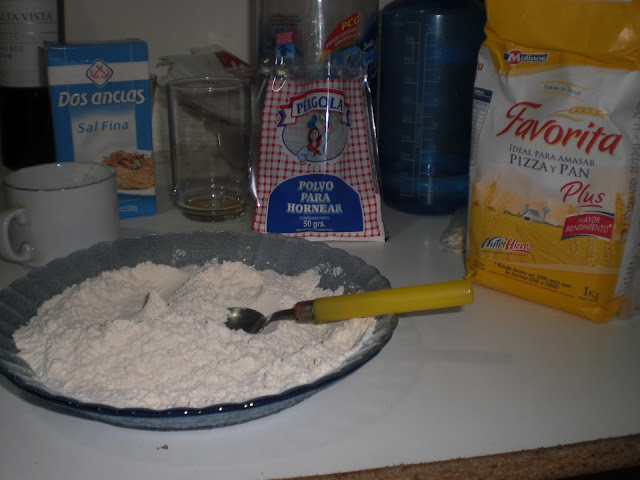 |
| "Here lived and were kidnapped..." This plaque is in the concrete outside an apartment building a block from our apartment. |
The city palpitates with a passion for soccer, food and community, as well as an economic nervousness. The Argentine economic collapse of 2001, when many lost their life's savings, is a vivid memory to porteños.
Another unhappy memory, more sinister than a faltering economy, is the military dictatorship that took place during the late seventies and early eighties. Kidnappings. Torture. 30,000 people disappeared. Los desaparecidos were alleged political dissidents. They were wives, husbands, teens, pregnant women - there were no boundaries. At the time of their disappearance, their families received no information about what happened to their loved ones.
We've met some people who will talk about this historical time and others who quickly and politely dismiss it and don't want to engage in the conversation. The wounds are too fresh. On an organized bike tour, we saw the excavation site of a recently discovered mass grave and torture site.
 |
| Site of mass grave - only discovered when the city began construction on an underground athletic center. |
After reading about the varied and beautiful neighborhoods of BA - Recoleta, San Telmo, La Boca Retiro, Palermo - we decided to rent a studio apartment in Palermo. Palermo Soho to be specific - a tree-lined neighborhood full of cute Anthropology-like shops, designer stores and cafes on every corner.
1. Bike Tours with Biking Buenos Aires & Graffitimundo
a. Graffitimundo bike tour - Part political and part art, graffiti is not discouraged here. Instead it lends playfulness to community spaces and brightens up otherwise dull or dark areas. Some homeowners ask the artists to paint their houses. Graffiti brought color to a bleak time following the 2001 economic crisis and continues to be accepted and supported.
b. Puerto Madero, San Telmo & La Boca - Tango started in La Boca. We saw the Boca soccer team stadium in La Boca. And we visited Puerto Madero which is a city within a city. It's only over the river from downtown, but feels like a metropolitan suburb worlds away with new tall buildings and fancy apartments.
2. Casa Rosada Tour
Casa Rosada is Argentina's equivalent to the White House. President Cristina Kirchner works here Monday through Friday and it is open on the weekends for free public tours.
Inside we walked two feet from Cristina's desk! You had to walk fast but were allowed to take pictures. Imagine getting such easy access to the Oval Office. Not happening.
Today Argentina is very supportive of the right to free speech. In front of the Casa Rosada is the Plaza de Mayo, where mothers of the disappeared march weekly wearing white headscarves.
 |
| This captures Buenos Aires pretty well - Casa Rosada, a permanent activist camp, sun bathers on the lawn. Merry Christmas! |
One of my favorite places is the Rosedal located in one of the largest parks in the middle of the city. It's a huge expanse of different colors and types of roses. We also visited the botanical gardens (free) and the Japanese Gardens ($2 entry). There is also a zoo near these gardens which we didn't visit, but what I noticed is that all these places are very easily accessible by subway and bus and inexpensive.
 |
| Tango in Recoleta neighborhood |
 |
| Typical weekend site in any of the number of green spaces |
The workshop took place in a gallery upstairs from a bar owned by artists. I expected to draw up a stencil, cut it out and take it home. Instead, we learned about the history of the stencil and how to design one. Then we cut out pre-designed stencils and added our own touch and then spray painted them on the wall of the bar. It was so fun!
 |
| upstairs at the bar & gallery |
 |
| my chicken-cat! |
 |
| spraypaint! |
 |
| My chicken-cat with John's blue pirate - he designed the body and legs. |
When I think of Frida Kahlo, I tend to think of her life story and marriage more than what a great artist she was. This painting reminded me of how talented she was.
I like living the big city life - buying vegetables & eggs at the vegetable/fruit stand a half-block from our apartment, taking the subway, drinking coffee at any of the million corner cafes, enjoying the plazas, taking the time to walk places, hearing a collective roar rumble through the neighborhood when the soccer team scores a goal. But it also takes a toll, so we headed to the town of Tigre an hour northeast of Buenos Aires for a tour of the delta.
6. Tigre Delta Tour
We toured the small town of Tigre and the river delta just outside of Buenos Aires. Pictures are here.
You can see all the Buenos Aires pictures here.
Next up...Uruguay!










































